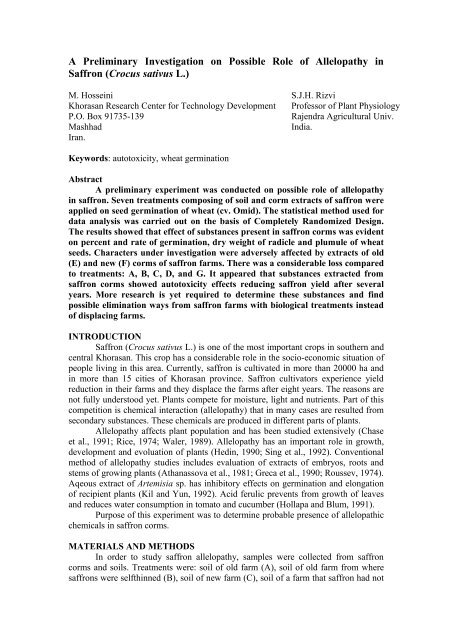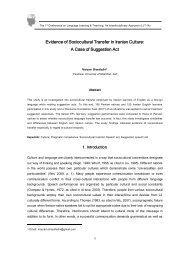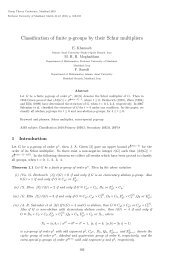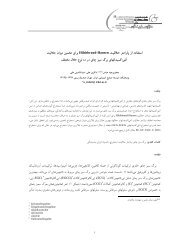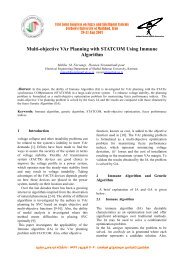A Preliminary Investigation on Possible Role of Allelopathy in Saffron
A Preliminary Investigation on Possible Role of Allelopathy in Saffron
A Preliminary Investigation on Possible Role of Allelopathy in Saffron
You also want an ePaper? Increase the reach of your titles
YUMPU automatically turns print PDFs into web optimized ePapers that Google loves.
A <str<strong>on</strong>g>Prelim<strong>in</strong>ary</str<strong>on</strong>g> <str<strong>on</strong>g>Investigati<strong>on</strong></str<strong>on</strong>g> <strong>on</strong> <strong>Possible</strong> <strong>Role</strong> <strong>of</strong> <strong>Allelopathy</strong> <strong>in</strong><br />
Saffr<strong>on</strong> (Crocus sativus L.)<br />
M. Hosse<strong>in</strong>i S.J.H. Rizvi<br />
Khorasan Research Center for Technology Development Pr<strong>of</strong>essor <strong>of</strong> Plant Physiology<br />
P.O. Box 91735-139<br />
Rajendra Agricultural Univ.<br />
Mashhad<br />
India.<br />
Iran.<br />
Keywords: autotoxicity, wheat germ<strong>in</strong>ati<strong>on</strong><br />
Abstract<br />
A prelim<strong>in</strong>ary experiment was c<strong>on</strong>ducted <strong>on</strong> possible role <strong>of</strong> allelopathy<br />
<strong>in</strong> saffr<strong>on</strong>. Seven treatments compos<strong>in</strong>g <strong>of</strong> soil and corm extracts <strong>of</strong> saffr<strong>on</strong> were<br />
applied <strong>on</strong> seed germ<strong>in</strong>ati<strong>on</strong> <strong>of</strong> wheat (cv. Omid). The statistical method used for<br />
data analysis was carried out <strong>on</strong> the basis <strong>of</strong> Completely Randomized Design.<br />
The results showed that effect <strong>of</strong> substances present <strong>in</strong> saffr<strong>on</strong> corms was evident<br />
<strong>on</strong> percent and rate <strong>of</strong> germ<strong>in</strong>ati<strong>on</strong>, dry weight <strong>of</strong> radicle and plumule <strong>of</strong> wheat<br />
seeds. Characters under <strong>in</strong>vestigati<strong>on</strong> were adversely affected by extracts <strong>of</strong> old<br />
(E) and new (F) corms <strong>of</strong> saffr<strong>on</strong> farms. There was a c<strong>on</strong>siderable loss compared<br />
to treatments: A, B, C, D, and G. It appeared that substances extracted from<br />
saffr<strong>on</strong> corms showed autotoxicity effects reduc<strong>in</strong>g saffr<strong>on</strong> yield after several<br />
years. More research is yet required to determ<strong>in</strong>e these substances and f<strong>in</strong>d<br />
possible elim<strong>in</strong>ati<strong>on</strong> ways from saffr<strong>on</strong> farms with biological treatments <strong>in</strong>stead<br />
<strong>of</strong> displac<strong>in</strong>g farms.<br />
INTRODUCTION<br />
Saffr<strong>on</strong> (Crocus sativus L.) is <strong>on</strong>e <strong>of</strong> the most important crops <strong>in</strong> southern and<br />
central Khorasan. This crop has a c<strong>on</strong>siderable role <strong>in</strong> the socio-ec<strong>on</strong>omic situati<strong>on</strong> <strong>of</strong><br />
people liv<strong>in</strong>g <strong>in</strong> this area. Currently, saffr<strong>on</strong> is cultivated <strong>in</strong> more than 20000 ha and<br />
<strong>in</strong> more than 15 cities <strong>of</strong> Khorasan prov<strong>in</strong>ce. Saffr<strong>on</strong> cultivators experience yield<br />
reducti<strong>on</strong> <strong>in</strong> their farms and they displace the farms after eight years. The reas<strong>on</strong>s are<br />
not fully understood yet. Plants compete for moisture, light and nutrients. Part <strong>of</strong> this<br />
competiti<strong>on</strong> is chemical <strong>in</strong>teracti<strong>on</strong> (allelopathy) that <strong>in</strong> many cases are resulted from<br />
sec<strong>on</strong>dary substances. These chemicals are produced <strong>in</strong> different parts <strong>of</strong> plants.<br />
<strong>Allelopathy</strong> affects plant populati<strong>on</strong> and has been studied extensively (Chase<br />
et al., 1991; Rice, 1974; Waler, 1989). <strong>Allelopathy</strong> has an important role <strong>in</strong> growth,<br />
development and evoluati<strong>on</strong> <strong>of</strong> plants (Hed<strong>in</strong>, 1990; S<strong>in</strong>g et al., 1992). C<strong>on</strong>venti<strong>on</strong>al<br />
method <strong>of</strong> allelopathy studies <strong>in</strong>cludes evaluati<strong>on</strong> <strong>of</strong> extracts <strong>of</strong> embryos, roots and<br />
stems <strong>of</strong> grow<strong>in</strong>g plants (Athanassova et al., 1981; Greca et al., 1990; Roussev, 1974).<br />
Aqeous extract <strong>of</strong> Artemisia sp. has <strong>in</strong>hibitory effects <strong>on</strong> germ<strong>in</strong>ati<strong>on</strong> and el<strong>on</strong>gati<strong>on</strong><br />
<strong>of</strong> recipient plants (Kil and Yun, 1992). Acid ferulic prevents from growth <strong>of</strong> leaves<br />
and reduces water c<strong>on</strong>sumpti<strong>on</strong> <strong>in</strong> tomato and cucumber (Hollapa and Blum, 1991).<br />
Purpose <strong>of</strong> this experiment was to determ<strong>in</strong>e probable presence <strong>of</strong> allelopathic<br />
chemicals <strong>in</strong> saffr<strong>on</strong> corms.<br />
MATERIALS AND METHODS<br />
In order to study saffr<strong>on</strong> allelopathy, samples were collected from saffr<strong>on</strong><br />
corms and soils. Treatments were: soil <strong>of</strong> old farm (A), soil <strong>of</strong> old farm from where<br />
saffr<strong>on</strong>s were selfth<strong>in</strong>ned (B), soil <strong>of</strong> new farm (C), soil <strong>of</strong> a farm that saffr<strong>on</strong> had not
een cultivated <strong>in</strong> was used as c<strong>on</strong>trol 1 (D), corm <strong>of</strong> old farm (E), corm <strong>of</strong> new farm<br />
(F), distilled water as c<strong>on</strong>trol 2 (G). Samples were collected <strong>in</strong> autumn 1998 from two<br />
year old saffr<strong>on</strong> farm (new <strong>on</strong>e) and from eight year old saffr<strong>on</strong> farm (old <strong>on</strong>e)<br />
located at the experimental stati<strong>on</strong> <strong>of</strong> saffr<strong>on</strong> and medic<strong>in</strong>al plants <strong>in</strong> Khezri, Ghaen.<br />
Samples <strong>of</strong> saffr<strong>on</strong> corms and soils were collected from depth <strong>of</strong> 25 cm from<br />
soil surface. They were sent immediately, frozen and kept at temperature -40 °C<br />
before c<strong>on</strong>duct<strong>in</strong>g the experiment.<br />
Samples were kept <strong>in</strong> the lab. temperature at least for two hours. Soil samples<br />
each <strong>on</strong>e was mixed completely and 100 g soil was mixed <strong>in</strong>to the beaker with 500 ml<br />
distilled water. Two collected corm samples, at first, separately were washed with<br />
water and then with distilled water. After this stage, each corm sample was kept <strong>in</strong><br />
80% ethyl alcohol for <strong>on</strong>e m<strong>in</strong>ute. 100 g corms was transported <strong>in</strong>to a gr<strong>in</strong>der and<br />
crushed with a little distilled water (Rizvi and Commun., 1997).<br />
It was poured <strong>in</strong>to a beaker with 500 ml distilled water. S<strong>in</strong>ce then, follow<strong>in</strong>g<br />
the experiments for soil and corm samples were similar. Samples were shook for at<br />
least 18 hours with a shaker <strong>in</strong> 30 °C. Then, soluti<strong>on</strong>s were centrifuged with 4000<br />
rpm. Solid phase was elim<strong>in</strong>ated and the rest was passed from a membrane filter for<br />
dec<strong>on</strong>tam<strong>in</strong>ati<strong>on</strong> <strong>of</strong> the microbes and the samples were transferred <strong>in</strong>to the<br />
refrigerator with 5 °C. Samples were kept <strong>in</strong> the lab. temperature for a while before<br />
operati<strong>on</strong>. In this stage, bioassay test was c<strong>on</strong>ducted <strong>on</strong> wheat seeds cv. Omid. Plates<br />
were sterilized <strong>in</strong> 150 °C and then the seeds were dis<strong>in</strong>fected with 50 % Benomyl<br />
fungicide. 15 cm plates were used with 50 seeds <strong>in</strong> each <strong>on</strong>e. 18 ml soluti<strong>on</strong> was<br />
added to each <strong>on</strong>e. Each treatment with 4 replicati<strong>on</strong>s was established. Wheat seed<br />
germ<strong>in</strong>ati<strong>on</strong> was tested <strong>in</strong> the darkness <strong>in</strong> 15 °C <strong>in</strong> the germ<strong>in</strong>ator. Germ<strong>in</strong>ati<strong>on</strong><br />
(length <strong>of</strong> radicle as much as half the seed length) was measured for 5 days. Rate <strong>of</strong><br />
germ<strong>in</strong>ati<strong>on</strong> was calculated with the follow<strong>in</strong>g equati<strong>on</strong> (MaGuire, 1962).<br />
M<br />
R.G.= ∑<br />
i D<br />
In which M is number <strong>of</strong> germ<strong>in</strong>ati<strong>on</strong> till i th day, and D is number <strong>of</strong> days spent from<br />
the beg<strong>in</strong>n<strong>in</strong>g <strong>of</strong> the test.<br />
Four wheat seeds were selected <strong>in</strong> each plate with four replicati<strong>on</strong>s for<br />
measurement <strong>of</strong> radicle and plumule dry weights. On the basis <strong>of</strong> growth, <strong>in</strong> the 5 th<br />
day plumules and radicles <strong>of</strong> the four seeds were put <strong>in</strong> an envelope and were kept <strong>in</strong><br />
an oven with 65 °C for 48 hours. Thus, their dry weights were measured. Results were<br />
analysed statistically as C.R.D. (P
Figure 2 (a) shows dry weight <strong>of</strong> wheat radicle affected by corm extract <strong>of</strong> old<br />
farm (E) and showed significant difference compared with c<strong>on</strong>trol 1 (D) and c<strong>on</strong>trol 2<br />
(G). Dry weight <strong>of</strong> radicle <strong>in</strong> four treatments related to soil and corm samples <strong>of</strong> new<br />
farm was affected by allelopathy but this effect was less than treatment related to<br />
corm <strong>of</strong> old farm. These chemicals also had negative effects <strong>on</strong> dry weight <strong>of</strong> wheat<br />
plumule (figure2b). Corm extracts <strong>of</strong> old farm (E) and new farm (F) reduced<br />
significantly dry weight <strong>of</strong> wheat plumule. Aqeous extract <strong>of</strong> leaves and roots <strong>of</strong><br />
Chenopodium murale also prevented from germ<strong>in</strong>ati<strong>on</strong> and growth <strong>of</strong> wheat and<br />
barley seedl<strong>in</strong>gs under laboratory c<strong>on</strong>diti<strong>on</strong>s (Qasem, 1993). Perez et al. (1991)<br />
reported about effects <strong>of</strong> excreted chemicals from wild oat roots <strong>on</strong> spr<strong>in</strong>g wheat.<br />
Ben-hamm<strong>on</strong>da et al. (2001) have reported that aqeous extract <strong>of</strong> barley reduces<br />
radicle and plumule growth <strong>of</strong> durum and bread wheat.<br />
Results show that there are allelopathic chemicals <strong>in</strong> saffr<strong>on</strong> corms. In order to<br />
determ<strong>in</strong>e these chemicals and their adverse effects <strong>on</strong> different stages <strong>of</strong> saffr<strong>on</strong><br />
growth and development as autotoxicity further researches are needed.<br />
Literature Cited<br />
Athanassova, D.P., Roussev, G. and K<strong>on</strong>stant<strong>in</strong>ov, K. 1981. Isolati<strong>on</strong> <strong>of</strong> specific<br />
factors from embryos <strong>of</strong> Ech<strong>in</strong>ochola crusgalli L. Plant Physiology, S<strong>of</strong>ia 7:<br />
78-85.<br />
Ben-Hammouda, M., Ghoral, H., Kremer, R.J. and Oueslati, O. 2001. Allelopathic<br />
effects <strong>of</strong> barely extracts <strong>on</strong> germ<strong>in</strong>ati<strong>on</strong> and seedl<strong>in</strong>gs growth <strong>of</strong> bread and durum<br />
wheats. Agr<strong>on</strong>omie 21:65-71.<br />
Chase, W.R., Nair, M.G. and Putnam, A.R. 1991. 2, 2- Oxo- 1”azobenzene: Selective<br />
toxicity <strong>of</strong> rye (Secale cereale L.) allelochemicals to weed and crop species. J.<br />
Chemic. Ecol. 17:9-19.<br />
Greca, M.D., Mang<strong>on</strong>i, I., Mol<strong>on</strong>aro, A., M<strong>on</strong>aco, P. and Previtera, L. 1990. (20S)-4-<br />
methylenecholes- 7- en- 3- ol an allelopathic sterol from Typha latifolia.<br />
Phytochemistry 29:1797-1798.<br />
Hed<strong>in</strong>, P.A. 1990. Bioregulator <strong>in</strong>duced changes <strong>in</strong> allelochemicals and their effects<br />
<strong>on</strong> plant resistance to pests. Crit. Rev. Plant Sci. 9:371-379.<br />
Hollapa, L.D. and Blum, U. 1991. Effects <strong>of</strong> exogenousely applied ferulic acid, a<br />
potential allelopathic compound, <strong>on</strong> leaf growth, water utilizati<strong>on</strong> and endogenous<br />
abscisic acid levels <strong>of</strong> tomato, cucumber and bean. J. Chem. Ecol. 17: 865-886.<br />
Kil, B.S and Yun, K.W. 1992. Allelopathic effects <strong>of</strong> water extracts <strong>of</strong> Artemisia<br />
pr<strong>in</strong>ces var. orientalis <strong>on</strong> selected plant species. J. Chem. Ecol. 18:39-51.<br />
MaGuire, J. D. 1962. Speed <strong>of</strong> germ<strong>in</strong>ati<strong>on</strong>, Aid <strong>in</strong> selecti<strong>on</strong> and evaluati<strong>on</strong> for<br />
seedl<strong>in</strong>g emergence and vigor. Crop Sci. 2:176-177.<br />
Perez, F.J. and Ormeno- Nunez, J. 1991. Root exudates <strong>of</strong> wild oats: Allelopathic<br />
effects <strong>on</strong> spr<strong>in</strong>g wheat. Phytochemistry (United K<strong>in</strong>gdom). 30:2199-2202.<br />
Qasem, J.R. 1993. Allelopathic effect <strong>of</strong> nettle- leaved goose foot (Chenopodium<br />
murale) <strong>on</strong> wheat and barely. Dirasat (Jordan). V. 20B (D). p. 84-94.<br />
Rice, E.L. 1974. <strong>Allelopathy</strong>. New York. Academic Press. 353 pp.<br />
Roussev, G. 1974. Programme <strong>of</strong> embry<strong>on</strong>ic development directed by <strong>on</strong>togen<strong>in</strong>es.<br />
S<strong>of</strong>ia: Science and Art. 298 PP.<br />
S<strong>in</strong>gh, K., Shahi, A.K., Pal, S. and Balyan, S.S. 1992. Phytoallelopathic <strong>in</strong>fluence <strong>of</strong><br />
Parthenium hystrophorus L. In: Proceed<strong>in</strong>gs <strong>of</strong> First Nati<strong>on</strong>al Symposium <strong>on</strong><br />
<strong>Allelopathy</strong> <strong>in</strong> Agroecosystems (Agriculture and Forestry) (Eds., P. Tauro and S.<br />
S. Narwal), pp. 61-63. Hisar, India: Indian Society <strong>of</strong> <strong>Allelopathy</strong>.
Waler, G.R. 1989. Biochemical fr<strong>on</strong>tiers <strong>of</strong> allelopathy. Biologia Plantarum<br />
31:418-447.
a)<br />
Percent <strong>of</strong> germ<strong>in</strong>ati<strong>on</strong><br />
60<br />
50<br />
40<br />
30<br />
20<br />
10<br />
a<br />
a<br />
a<br />
a<br />
b<br />
b<br />
a<br />
0<br />
A B C D E F G<br />
b)<br />
Treatments<br />
Rate <strong>of</strong> germ<strong>in</strong>ati<strong>on</strong><br />
16<br />
14<br />
12<br />
10<br />
8<br />
6<br />
4<br />
2<br />
0<br />
a<br />
a<br />
a<br />
a<br />
a<br />
b<br />
b<br />
A B C D E F G<br />
Treatments<br />
Fig. 1. Effects <strong>of</strong> different treatments <strong>of</strong> soils and corms <strong>of</strong> saffr<strong>on</strong> <strong>on</strong> percent <strong>of</strong><br />
germ<strong>in</strong>ati<strong>on</strong> (a) and rate <strong>of</strong> germ<strong>in</strong>ati<strong>on</strong> (b) <strong>in</strong> wheat seed. A: soil <strong>of</strong> old farm, B:<br />
soil <strong>of</strong> old farm from where saffr<strong>on</strong> was selfth<strong>in</strong>ned, C: soil <strong>of</strong> new farm, D: soil<br />
<strong>of</strong> no saffr<strong>on</strong> cultivated (c<strong>on</strong>trol 1), E: corm <strong>of</strong> old farm, F: corm <strong>of</strong> new farm, G:<br />
distilled water (c<strong>on</strong>trol 2).
Dry weight <strong>of</strong> plumule (gr) Dry weight <strong>of</strong> radicle (gr)<br />
0.025<br />
0.02<br />
0.015<br />
0.01<br />
0.005<br />
0<br />
0.045<br />
0.04<br />
0.035<br />
0.03<br />
0.025<br />
0.02<br />
0.015<br />
0.01<br />
0.005<br />
0<br />
(a)<br />
a<br />
a<br />
a<br />
a<br />
a<br />
b<br />
b<br />
A B C D E F G<br />
Treatments<br />
(b)<br />
a<br />
a<br />
a<br />
a<br />
a<br />
b<br />
b<br />
A B C D E F G<br />
Treatments<br />
Fig. 2. Effects <strong>of</strong> different treatments <strong>of</strong> soils and corms <strong>of</strong> saffr<strong>on</strong> <strong>on</strong> dry weight <strong>of</strong><br />
radicle (a) and dry weight <strong>of</strong> plumule (b) <strong>in</strong> wheat seed. A: soil <strong>of</strong> old farm, B: soil<br />
<strong>of</strong> old farm from where saffr<strong>on</strong> was selfth<strong>in</strong>ned, C: soil <strong>of</strong> new farm, D: soil <strong>of</strong> no<br />
saffr<strong>on</strong> cultivated (c<strong>on</strong>trol 1), E: corm <strong>of</strong> old farm, F: corm <strong>of</strong> new farm, G:<br />
distilled water (c<strong>on</strong>trol 2).


